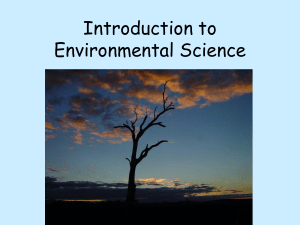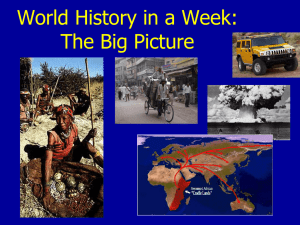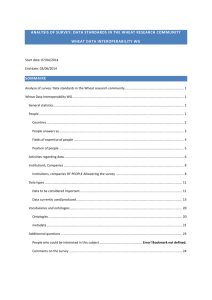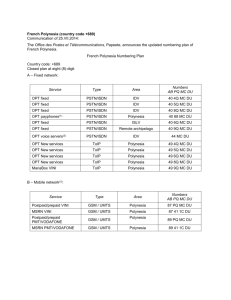Overview of Human Impacts and History
advertisement
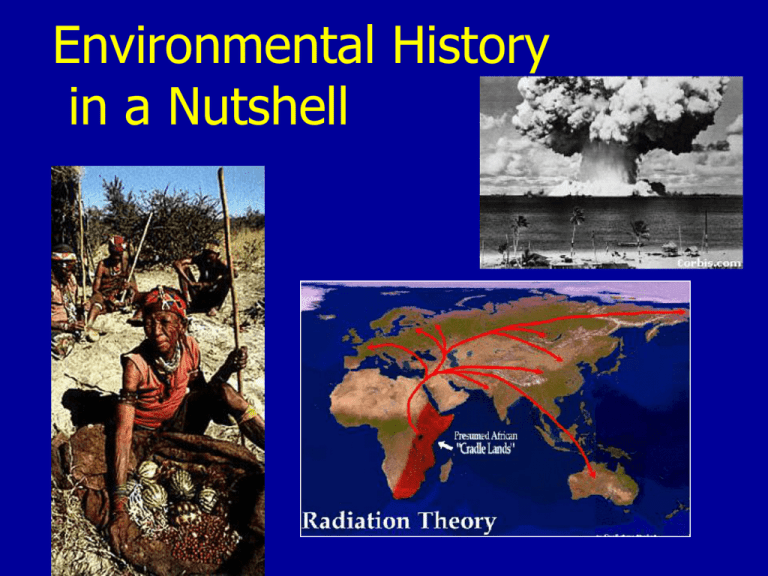
Environmental History in a Nutshell Geologic Time Pretend the age of the earth (4.5+ billion years) is compressed into one calendar year. January 1 - Earth and planets formed Early March - liquid water stands in pools. Late March - earliest life July - oxygen is important part of atmosphere October 25 - multicellular organisms Late November - plants and animals abundant December 15 to 25 - dinosaurs arise and disappear 11:20 pm, December 31 - Humans appear One second before midnight - Automobile invented • • • • When did Humans arrive on the scene? Age of hominids? 5-7 million years Homo erectus? 2 million years Homo sapiens? 250,000 years Neanderthals? 140,000-50,000 y.a. – Separate evolutionary line? First genocide? • Cro-Magnon invasion of Europe? 40,000 y.a. (fully modern anatomy) Australopithecus afarensis Homo erectus Hominid Development? Hunter-Gatherers • Humanities only “economic” activity for at least 90% of our existence. • Low population densities (small groups of 40-60; 1 person/ mi2) • Largely egalitarian - every person performs essential functions. Great Leap Forward Lascaux Caves, France When? present 70,000 years before Emergence of modern hunter-gatherer “toolbox”: • Fish hooks, Arrows, Bows, Needles, Engravers, Awls • Art • Jewelry (Beads at first) • Navigation/Boating? (Australia from New Guinea) Proposed Causes: • Voicebox development / language • Brain organization change Human Expansion Population growth and resulting need for more land and resources leads to migration. Pleistocene Overkill Hypothesis • Large, slow, or tame animals become extinct shortly after hunter-gatherer arrival in New World, Polynesia, Australia / New Guinea. – Flightless birds, giant cave bear, ground sloth. Giant Extinct Moa, New Zealand Skeleton of Giant Ground Sloth, Los Angeles Human Expansion “Out of Africa” Based on Archaeological and Fossil Evidence Including Homo erectus and Homo neanderthalensis Human Expansion: based on mitochondrial DNA study of Homo sapiens Agricultural Revolution Domestication of Plants and Animals • Seed Agriculture - Fertile Crescent, western India, northern China, Ethiopia, southern Mexico (10,000 b.p.) Rice, wheat, and corn account for more than 50% of world population's food calories and were among the first plants domesticated (along with millet, sorghum wheat, rye, barley). Agricultural Revolution Source: Goudie, Andrew. 2006. Human Impact on the Natural Environment. Domestication of Plants Neolithic Revolution Rice, wheat, and corn account for more than 50% of world population's food calories and were among the first plants domesticated (along with millet, sorghum wheat, rye, barley). and Animals Dog was probably first. Early domesticated animals: cattle, oxen, pigs, sheep, goats, guinea pigs, llama • role in agricultural production and success Agricultural Revolution Source: Goudie, Andrew. 2006. Human Impact on the Natural Environment. Agricultural Revolution Primary effects: Urbanization Social Stratification Occupational Specialization Increased population densities Teotihuacan Human Expansion and Ancient Agricultural Empires Urbanization and increased efficiency lead to population growth, increased consumption and higher density, which leads to need for more space and more natural resources. Ancient Examples: Aztecs, Maya Chinese Warlords / Dynasties Polynesians Roman Empire Muslim / Ottoman Empire Human and environmental costs are inevitable. Natural Experiments in Environmental Studies • Successful cultures are those that adapt well to their environments. Many have not: Chaco Canyon, North Africa, Fertile Crescent, Easter Island. Chaco Canyon, New Mexico Easter Island, Polynesia Agricultural and Industrial Societies Accelerate Extinctions • Flightless birds, whales, otters • U.S. Passenger Pigeon Mauritius, Indian Ocean Dodo Bird discovered in 1598, extinct by 1681. Dodo Bird, Mauritius, Indian Ocean Age of European Discovery, Exploration, and Colonization 1492 - 1771: Bartholomew Dias (Portugal), 1488 - rounds Cape of Good Hope Columbus, 1492 (Spanish/Italian) - first of four voyages to “New World” Vasco De Gama (Portugal), 1498 - reaches India Magellan (Portugal), 1519 - First Circumnavigation James Cook (England), 1768-1771 - voyages in Pacific / Polynesia; end of era of Discovery The geographical knowledge acquired was crucial to the expansion of European political and economic power in the 16th Century. Captain James Cook Source: Microsoft Encarta Encyclopedia, 2007. World Migration Routes Since 1700 European African (slaves) Indian Chinese Japanese Majority of population descended from immigrants Slide graphic courtesy of Dr. Jean-Paul Rodrigue, Hofstra University Industrial Revolution (The Atlantic-industrial Era) Belt of industrial cities form an economic core based on fossil fuel consumption. 1733, First Cotton Mill opens in England 1793, Eli Whitney invents cotton ‘gin 1800, steam engines become common (steamboats, locomotives) 1837, Morse (and two Brits, independent of Morse ) invent telegraph 1877, Bell invents telephone 1908, Henry Ford delivers first Model T Environmental Effects? • Energy Consumption • Natural Resources • Land Use Global Communications and Transportation Revolution (Pacific-global era) Technology: Inexpensive International Air Transport (1960s - present) Internet and earlier Arpanet (1960s) Personal Computer (1980s) Satellite Communications (1990s) Containerization of Cargo (1950s) Globalization of Economies - Rise of Transnational Corporations Environmental Effects? Globalization Nearly everything moves farther and more quickly today: Innovations, Diseases, People, Ideologies, Financial Crises, Information. How does this affect the environment? 25 Largest Multinational Corporations, 2007 Source: Global Policy Forum (www.globalpolicy.org) Today’s Technological Revolution What emerging technologies will change the world? Which parts of the world stand poised to capitalize on them? Genetic Engineering and Biotechnology Artificial Intelligence Robotics and micro-robotics Nanotechnology Economic Globalization Environmental Effects? Human Population Growth Source: Data from U.S. Census Bureau World Population Clock (click) Population and the Environment I=PxAxT (Impact = Population x Affluence x Technology) Population-influenced environmental problems: • Global Warming • Habitat Loss / Endangered Species • Resource Depletion • Food Production Population, Affluence, and Resource Consumption Population, Affluence, and Resource Consumption Source: World Bank, 2012: siteresources.worldbank.org/ Technology, Energy Consumption, and Environmental Impact There has been a dramatic increase in: • individual energy use over time: 3,000 kcal/person 300,000 kcal/person (each of us in the U.S. has the equivalent of about 100 energy servants) • the power of technology to change the environment: think stone axe versus bulldozer versus atomic bomb. • the scope and severity of environmental impacts. Individual Annual Energy Use (Goudie, 2006) Human Impact on the Planet, 2002 Red on this map represents roads, power lines, major landscape change (e.g. agriculture), pipelines, and urbanized areas. Source: UNEP, 2002 • • • • • • • • State of the Planet half the world’s wetlands were lost during the last century; logging and land use conversion have reduced forest cover by at least 20 per cent, and possibly as much as 50 per cent; nearly 70 per cent of the world’s major marine fish stocks are either overfished or being fished at the biological limit; over the last half century, soil degradation has affected two-thirds of the world’s agricultural land. It is estimated that each year some 25 000 million metric tonnes of fertile topsoil—the equivalent of all of the wheat fields in Australia— is lost globally (Casagrande and Zaidman 1999); each year, an estimated 27 000 species disappear from the planet— approximately one every 20 minutes (Casagrande and Zaidman 1999); the Earth now appears to be experiencing a sixth mass extinction event that began about 50 000 years ago with the expanding role of humans in the world (Recer 2004). Unlike past events, this mass extinction is being caused by human activities such as transforming the landscape, overexploiting species, pollution, and alien species introductions (Eldredge 2001); dams and engineering works have fragmented 60 per cent of the world’s large river systems. They have so impeded water flow that the time it takes for a drop of water to reach the sea has tripled; human activities are significantly altering the basic chemical cycles upon which all ecosystems depend (Kirby 2000). Source: UNEP, A Story of Change, One Planet, Many People. 2005. http://na.unep.net/atlas/onePlanetManyPeople/book.php Carrying Capacity and Ecological Footprint The carrying capacity of a biological species in an environment is the population size of the species that the environment can sustain indefinitely, given the food, habitat, water and other necessities available in the environment. For the human population, more complex variables such as sanitation and medical care are sometimes considered as part of the necessary infrastructure. The ecological footprint is a measure of human demand on the Earth's ecosystems. It compares human demand with planet Earth's ecological capacity to regenerate. It represents the amount of biologically productive land and sea area needed to regenerate the resources a human population consumes and to absorb and render harmless the corresponding waste. Ecological Footprint Calculator Sustainable Development The ability of humanity to ensure that it meets the needs of the present without compromising the ability of future generations to meet their own needs. (The World Commission on Environment and Development’s (the Brundtland Commission) report ”Our Common Future”, 1987) Sustainable development involves a triple bottom line: the simultaneous pursuit of economic prosperity, environmental quality (World Business Council on Sustainable Development) and social equity. Video Link - TED Talk: Johan Rockstrom


